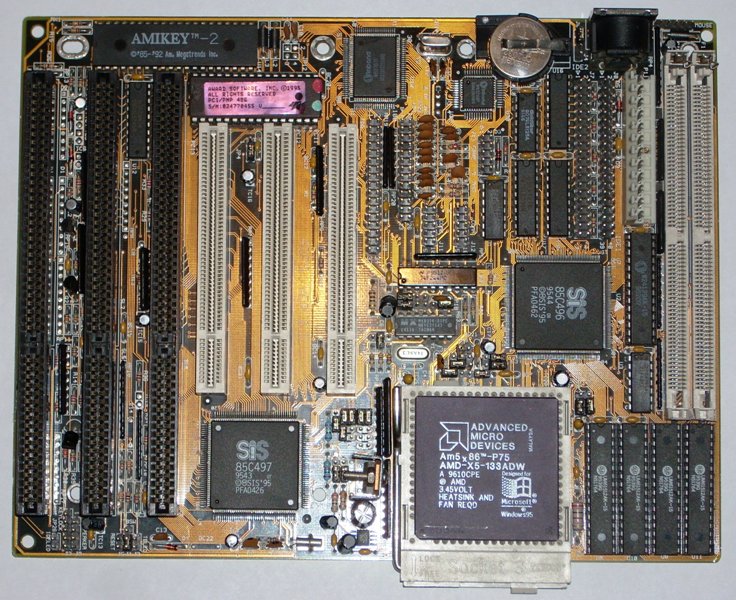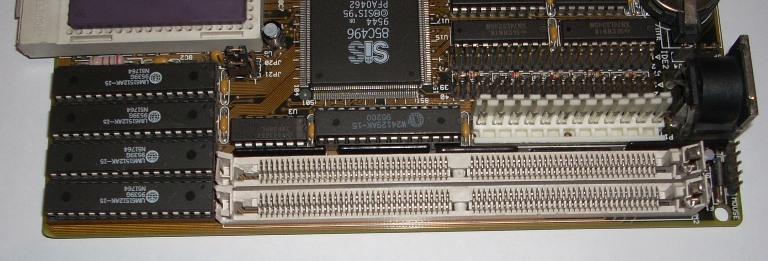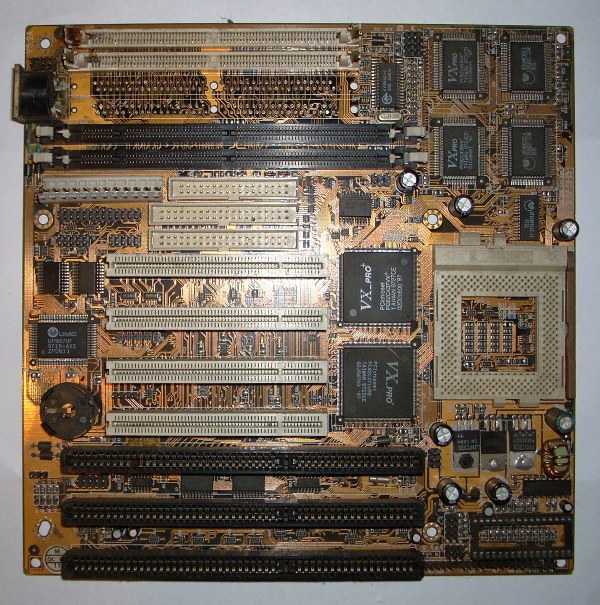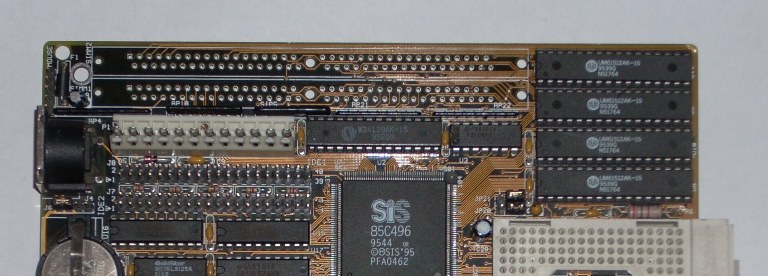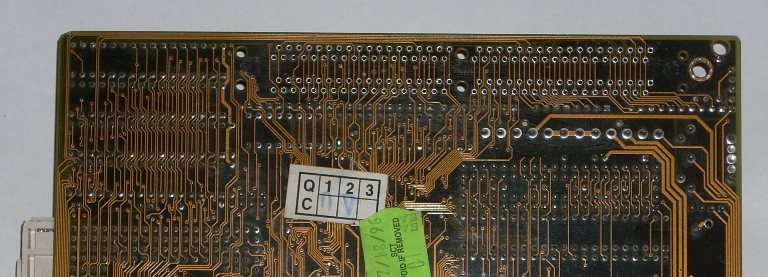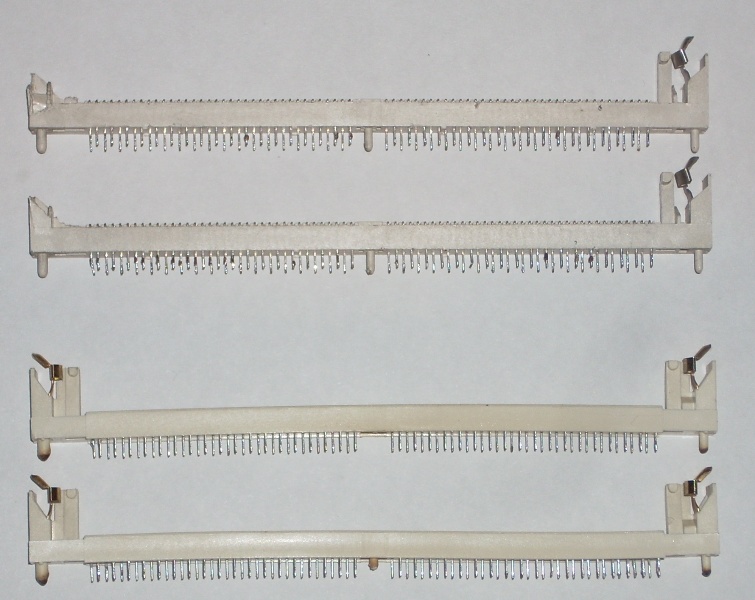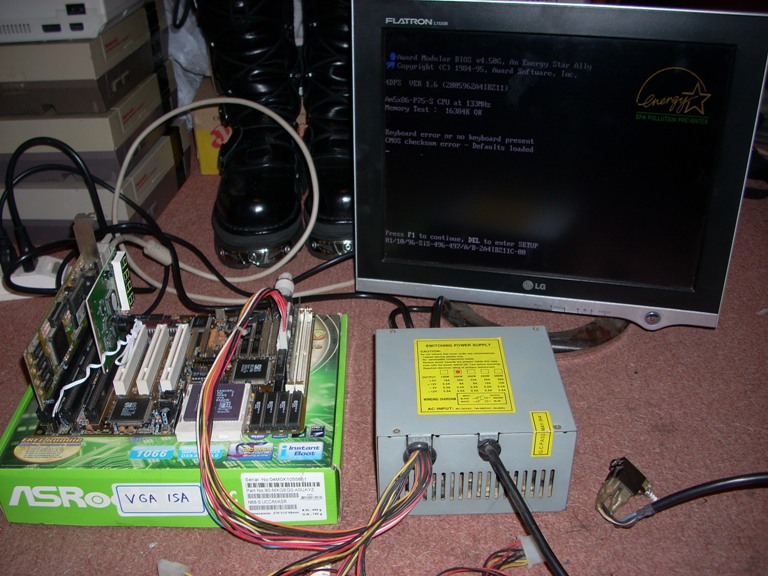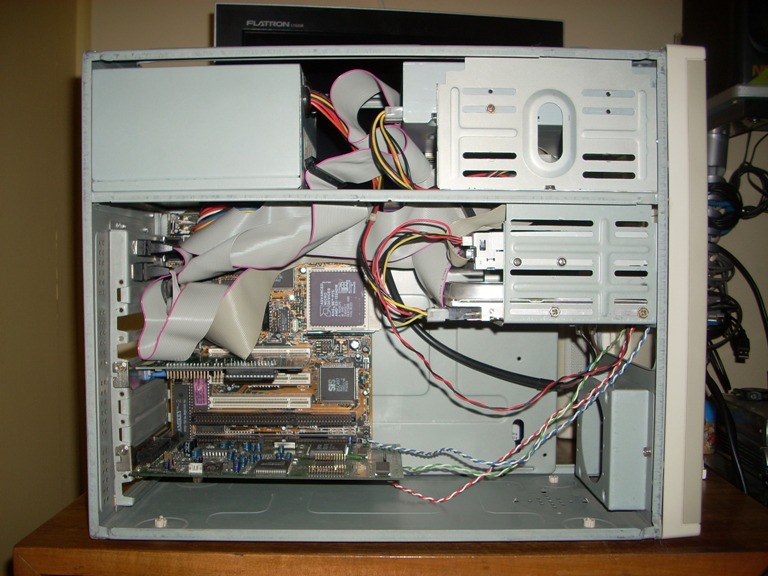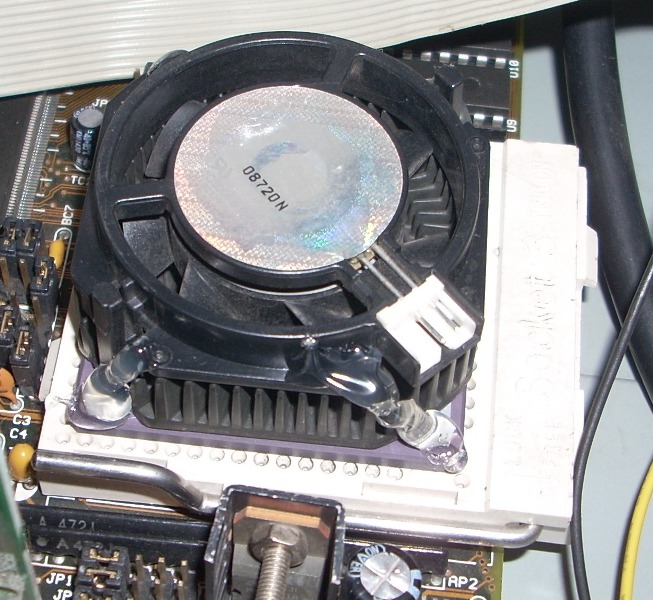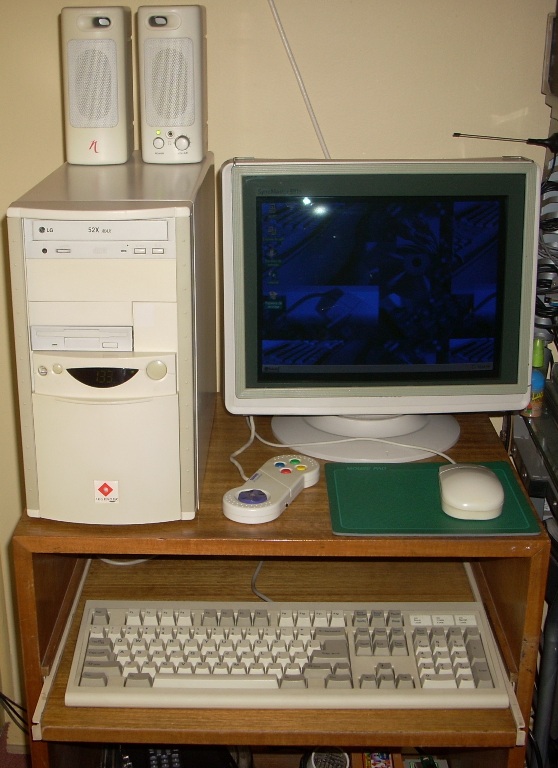First post, by 133MHz
- Rank
- Oldbie
A bit of story... as a (geeky) teenager in the early 2000s I used to make a bit of money building and repairing PCs in my spare time, usual stuff. People would donate their old hardware to me or I'd just pick it up from the curb, anything good would go to upgrade the PCs in my house first, and the rest was built into usable machines which I'd sell or give to people who need them. I love tinkering with old hardware so I got much enjoyment out of it. I lived in a small house with an enclosed, roofed patio which quickly became my 'operations center'.
Back then, Socket 3 stuff was EVERYWHERE, I was full to the brim with Socket 3 motherboards, 486 CPUs and an assortment of RAM and ISA cards that came with them. When I would receive or find an old computer, 9 times out of 10 it'd be a 486, so that's the kind of hardware I tinkered with the most. I consider myself a spoiled child since I grew up with a Pentium PC when they were state of the art (and everybody had 486s or older if they had a computer at all). My father spent a big pile of cash on a powerful PC for his graphic design work (and video games!).
At first there was a market for old 486s, people would pick them up as a cheap spare PC for the kids to play games on, for light office work or even very light web browsing, even then I was getting more 486 stuff than I could get rid of. At one point they just became hopelessly obsolete and nobody would want them. I collected an enormous amount of old hardware I couldn't bring myself to throw out, and everywhere I looked, more Socket 3 stuff popped up. And don't make me get started on CRT monitors!
As I grew older I got bored of the old stuff and started tinkering with newer hardware, also my mother was becoming upset about my obsolete hardware hoarding (since we lived in a pretty small place). At one point a non-obvious roof leak killed a whole bunch of motherboards and ISA cards I had in cardboard boxes, when it rained the backs of the boxes got soaking wet and I didn't notice until their contents turned into a big pile of rust. That incident and my mother talking about moving to a bigger house but not wanting me to fill it up with this "obsolete junk" among other things made me take the difficult decision of throwing almost everything away (I only kept the SoundBlaster cards and a handful of components I deemed worthwhile). I tried to take it as a (hopefully) positive change in lifestyle and a sign of growing up and moving on. I did move to a bigger place and I started focusing on electronics (my childhood passion) and video game consoles.
Back to the present... Pre-Pentium stuff is now non-existant around here! I see you guys complaining about the high prices of old hardware on eBay, but here if you search for anything 486 or older on MercadoLibre (the Latin American eBay subsidiary) you get zero results. No more 486 or older stuff on recycling centers, thrift stores, or lying on the curb. Nothing. Not even scrappers would take such old hardware nowadays. I have come to the sad realization that it must all be in landfills now. 😢
Fortunately I managed to keep enough stuff around to build myself a decent working 486 rig which I'll surely post about here once I get it out of storage and remember what kind of hardware I put in it! 😵
So what does it all have to do with the point of this post? For all the Socket 3 stuff I got my hands on over the years, the only 5x86 CPU I got was a loose Evergreen Technologies 5x86 133 upgrade with two broken pins, I tried to kludge two makeshift pins with thin pieces of copper wire to try to test it out but it didn't boot so I proclaimed it as dead (I might still have that processor lying around somewhere). Besides that, I've never had, seen or used another 5x86 machine in my life.
Some time ago I was talking to a friend and I mentioned that I've never seen or used a working 586, and I'd like to get my hands on one but seeing how 486 stuff has pretty much disappeared around here I'd be better off forgetting about it. He mentioned that he did have an AMD 5x86 machine at some point, and that he'll be on the lookout. Months passed and one day he calls me. "I got you a 5x86 CPU with a motherboard!" he exclaimed. "I got it at a flea market for (roughly) US$2. You wanted one so it's yours to keep." I haven't been this excited for a piece of retro hardware in ages!
The day we meet again he brings it to my house, it's a nice Tomato 4DPS VER 2.0 (but says 1.6 on the BIOS) with an AMD Am5x86-P75 ADW.
I spotted that the 24.xx MHz crystal (which I presume belongs to the Super I/O controller) was dangling on one leg, a quick touch-up with my soldering iron fixed that. My friend was also curious to see if the board worked so he made me improvise a test rig to find out. But when I was going to put in a RAM stick...
...I noticed that the SIMM slots are broken, both 72-pin memory slots are missing one clip to hold the memory module in place. I tried putting the memory in anyway - it wouldn't POST, one clip doesn't cut it. If I held the module in place firmly with my hand it would POST, but the slightest movement would glitch or hang up the system, what a disappointment. I don't have any other working PCI Socket 3 board (or any 5x86 compatible Socket 3 board for that matter) and my chances of getting one nowadays are slim to none. I was really enthusiastic about putting together a 5x86 based rig and this was a big show-stopper. At one point I was thinking of hot-gluing the RAM sticks in place just so that I could use the mobo, but that would be a huge pain if I wanted to experiment and I don't see that being very reliable either, so I just put the board away for the time being.
The proper solution would be to replace both broken SIMM slots with good ones taken from a non-working motherboard. I am an electronics technician and I own proper soldering equipment (temperature controlled soldering iron and a hot air SMD rework station) so I think I should be able to do it. The only PC motherboard repair I've done in the past is replacing blown capacitors on Dell Optiplex motherboards, and even with the proper tools soldering/desoldering through-hole stuff on a motherboard is no easy task. I knew I'd do it some day, I just need to get into the right mood 🙄, but it seems that wasn't going to happen anytime soon. 😒
In the meantime I think I got the right motivation thanks to some nifty hardware findings. I worked at an electronics store last year and about a month ago my then-supervisor calls me. "Hey, sadly this place is closing down in a few days so we need to get rid of a bunch of stuff lying around in the office. I know you're into PC hardware so I've salvaged a few goodies for you." I went there and came home packed with useful stuff like ATX PSUs, mice, assorted cables (power/serial/parallel/USB/etc), adapters and whatnot. I also got a SoundBlaster AWE64 Value card, a Gravis PC GamePad, some SCSI hard drives, some ADB Apple keyboards/mice and some other stuff I can't remember now. 😁 Next I found out that one of my friends got a bunch of PCI video cards that were discarded at his workplace - two S3 Trio64 cards, two Matrox cards and an ATi Rage Pro (if I remember correctly), he was going to salvage the Flash BIOS chips and scrap the cards (!!!) so I offered him a bunch of EEPROM/Flash chips if he let me keep the video cards, which he accepted!
Since I now have some video cards and a sound card I got motivated to repair the 4DPS motherboard. First I removed two 72-pin SIMM slots from a junked Socket 7 board, which I got non-working and with some corrosion on the top left corner. Fortunately for me two of the slots didn't have any rust! I used a heat gun to remove them since the board is junk anyway.
I couldn't use the heat gun on the 4DPS if I wanted it to survive the procedure, and the hot air rework station is not powerful enough to do large through-hole components on heat-sucking multi-layer boards, so I had to do it the old-fashioned way, desolder every pin with a soldering iron and a desoldering pump.
I believe I spent about an hour doing each slot, if you've tried to desolder through-hole components from a PC motherboard you'll know what I mean. Too little heat and you'll be waiting ages for the solder to melt, too much and you risk delaminating the board or breaking the vias, if you try to rush it you'll ruin the board for sure. Gotta take your time and have lots of patience, you'll need it for those stubborn pins that refuse to come loose. It wasn't as bad as I thought it would, though.
Finally I got the broken SIMM slots off without too much noticeable damage to the motherboard.
Now comes the easy (and actually enjoyable) part, soldering the good slots into place! Here are both pairs of 72-pin SIMM slots before installation:
I didn't take a picture of the finished board in case Murphy decided to do its thing, it was already late in the night so I improvised a test rig on my bedroom floor just to see if the board would POST:
...and it did! It's alive! 😁
The next day I tried both slots and they passed memtest86 with flying colors so I started building my long-awaited 5x86 box!
- Tomato 4DPS VER 2.0 (BIOS 1.6)
- AMD Am5x86-X5-133ADW @ 133 MHz (33.3 x 4)
- 24 MB (16+8MB) FPM RAM (largest FPM sticks I had in my RAM stash - unfortunately this board doesn't support EDO)
- S3 Trio64V+ 2MB (chose that one because I've read here that it's got great DOS compatibility)
- Creative SoundBlaster AWE64 Value
- 4.1 GB Seagate IDE HDD
- Generic Baby AT case with 200W PSU
- LG 52X CD-ROM drive (what I had on hand)
- Microsoft Windows 95B
This was my last spare AT-style PC case, and they can't be easily found anymore. 🙁
It was filthy of course, but it cleaned up really well with some Cif and a dishwashing sponge!
Later I added a cable to route PC speaker sound to the AWE64's PC_SPK input since I didn't have any PC speaker at hand. Another thing I don't have anymore are Socket 3 heatsinks 🙁, nor do I have Socket 7 or 370 heatsinks with the required three-hole mounting as an alternative. For some reason I had a loose Pentium heatsink (those that came permanently glued to the CPU itself) which I ended up hot-gluing to the chip as a desperate measure, while I try to find a suitable heatsink:
I also had to re-wire two serial port brackets for use with this PC because the COM headers on this board use a 'straight' pinout instead of following the IDC pin numbers.
Obligatory SST 4.78 screenshot:
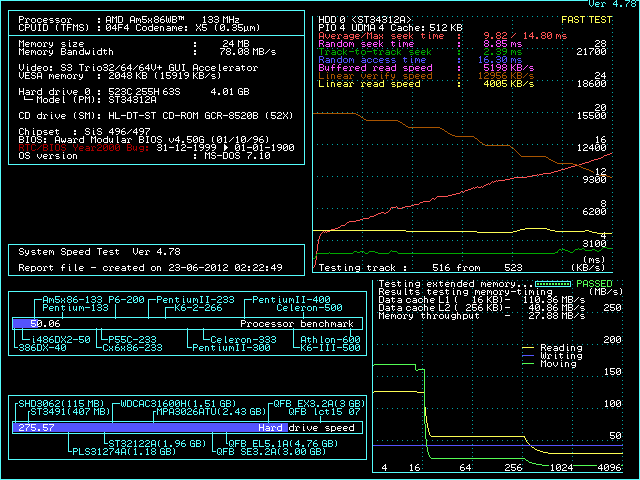
PCPBench score: 8.5 FPS (LFB)
And finally...
Had an awesome weekend playing the DOS games of my childhood with a gamepad (which I didn't have back then) and some sweet SB AWE music. 😎
I've gotta thank VOGONS for reviving my interest in retro PC hardware, this is such an awesome community with awesome people behind it. 😉
